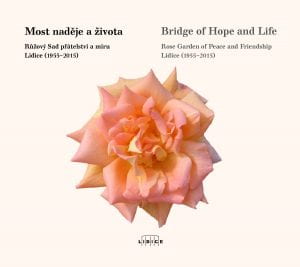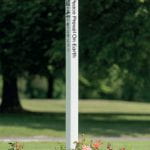- Women and children were the first gardeners at “new” (nove) Lidice.
- Women who returned from Ravensbruck to Lidice were the first gardeners.
- New homes welcomed the women of Lidice who returned from Ravensbruck. Over the years, the lines have softened between “new” Lidice and the Garden of Peace and Friendship.
- In memory of the lost children of Lidice.
- Visitors tour the grounds that today bloom with 24,000 rose plants.
- Young roses at the base of a peace pillar.

Roses for healing and remembrance
Roses on 24,000 shrubs bloom today (photo above) at the Rose Garden of Peace and Friendship, designed across 8 gently sloping acres in the shape of a rose with leaves and thorns, a smaller rose, and a bud.
In the garden’s early days (right and below), women and children tended the garden, which developed through the efforts and influence of Sir Barnett Stross, a British physician and parliamentarian.
The design incorporates dark red roses in the main rose beds, extending to the stylized leaves and thorns to signify the blood of the Lidice men who were executed by firing squad June 10, 1942. Fiery red roses mingle in these beds to remember the village buildings the Nazis set on fire, including St. Martin’s Church.
A smaller rose shape, whose beds are planted in shades of pink, signifies the village women who were separated from their children and sent to Ravensbruck concentration camp.
The garden’s smaller rosebud-designed bed, planted in memory of the lost children of Lidice, displays white and pastel roses.
Images courtesy of the archive of The Lidice Memorial (Pamatnik Lidice).
Below, the book cover for “Bridge of Hope and Life,” by Premysl Veverka, Luba Hedlova and Jiri Zlebcik. Photos by Martin Homola. Czech-to-English translation by Hana Stankova. Publisher: Pamatnik Lidice and The Ministry of Culture of the Czech Republic.
Aerial view of the rose garden design, a stylized rose with smaller rose and rosebud.
Timeline photos (to be posted) illustrate development of The Garden of Peace and Friendship, inspired and funded in large part during the 1950s by Sir Barnett Stross of Great Britain and the “Lidice Shall Live” committee. The city of Coventry, England, donated the first 1,000 plants, and cities across Great Britain soon followed suit. By the time the garden opened in June 1955, peace committees from other countries had donated thousands more rose plants for the garden. Sited on a gentle, terraced slope, the garden opened to the public June 19, 1955, with 17,000 rose plants. Today it has more than 24,000.
Copyright 2017 by Elizabeth Cernota Clark









